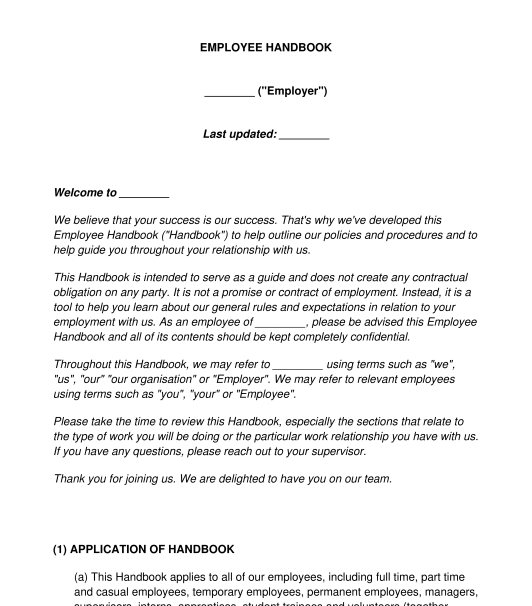 22/09/2025
22/09/2025

Answer a few questions and your document is created automatically.

Your document is ready! You will receive it in Word and PDF formats. You will be able to modify it.




Rating: 4.8 - 61 votes
Fill out the templateAn Employee Handbook is a document, established by an employer, which outlines the rules, practices, and procedures for employees at the employer's organisation. In an Employee Handbook, the employer informs employees about the standards that are expected of them. The employer also generally lets employees know about important information like benefits and time off.
Most Employee Handbooks are not meant to be absolutely comprehensive guides on everything surrounding the employment relationship. Rather, they are baselines for employer policies, through which employees can also find out how to access any additional information they may need.
An Employment Agreement is a specific contract used for just one individual and the employer. It can be negotiated and adapted for the specific employee, and will cover such details as their rate of pay, and their various duties. An Employee Handbook on the other hand is much more general, outlining the general policies and expectations that will apply to all employees - such as how and when employee pays are processed, any presentation standards, leave entitlements and how it is managed, safety procedures, fire procedures, car parking, and various other matters.
Employee Handbooks are not generally intended to be contractually binding on the employee. Instead, they explain the employer's general rules, procedures and expectations of employees. As a consequence, if the employer fails to follow a particular policy, the employee will not be able to claim that the employer has breached its contractual obligations. However, this also means that if there are specific matters of importance, that should be legally binding on the employee (such as their specific job duties, their hours of work, confidentiality obligations, or conflict of interest obligations), then the employer should make sure that these are addressed in a legally binding document, such as an Employment Agreement, a Confidentiality Agreement or a Non-Compete Agreement.
Generally, Employee Handbooks don't have to be approved by the employees. While Employment Agreements are often negotiated between employees and employers, Employee Handbooks are more of a reference point regarding the employer's standard procedures and guidelines.
In addition to this Employee Handbook, there are various other employment policies that employers should consider, such as:
Each of these policies deals with a specific workplace issue (such as drug and alcohol use, discrimination, or social media). The Employee Handbook provides a more general overview of the employer's general rules, standards and expectations of employees.
No, but it is a good idea as it provides a clear written description of the employer's expectations, and helps ensure that all employees understand their rights and obligations at work.
Unlike an Employment Agreement, employees do not necessarily need to sign an Employee Handbook. Instead, an Employee Handbook is just created by the employer (or someone in the employer's HR department).
However, it is important that the Employee Handbook is actually communicated to employees. Therefore, many employers do actually get their employees to sign a copy of the Handbook to confirm that they have received it and understood it.
Once an Employee Handbook is ready, it should be printed and/or saved electronically and kept on file with the employer, and employees should be made aware of it. For example, any existing employees should be notified of it and given a copy of it.
In addition, each time a new employee starts work with the employer, the new employee should be given a copy of the Handbook. Copies should also be left in places where employees frequently go, such as staff rooms, staff restaurants or staff common areas.
If the employer is getting employees to sign this Handbook, the employer should get each employee to return a signed signature page, and should keep those signed pages on file.
From time to time, if the employer implements new rules or policies, it may be necessary to update the Handbook. When this occurs, the employer may notify employees of the updates, and release a new version of the Handbook. The employer may ask employees to sign a new signature page at that time, to acknowledge the updated Handbook.
There are no hard and fast rules about what must be included in an Employee Handbook in Australia. However, the following details are worth considering:
The Fair Work Act 2009 (Cth) applies the National Employment Standards (NES), which are a set of minimum employment standards in Australia.
In addition, each state and territory has legislation that deals with various employment matters such as occupational health and safety or discrimination.
This Employee Handbook does not take into account the requirements of modern awards or enterprise agreements. If such an award or agreement applies, then that will set out some additional minimum standards with which the employer must comply.
General principles of contract law, as provided by the common law, may also apply.
You fill out a form. The document is created before your eyes as you respond to the questions.
At the end, you receive it in Word and PDF formats. You can modify it and reuse it.
Guides to help you
Employee Handbook - sample template - Word and PDF
Country: Australia